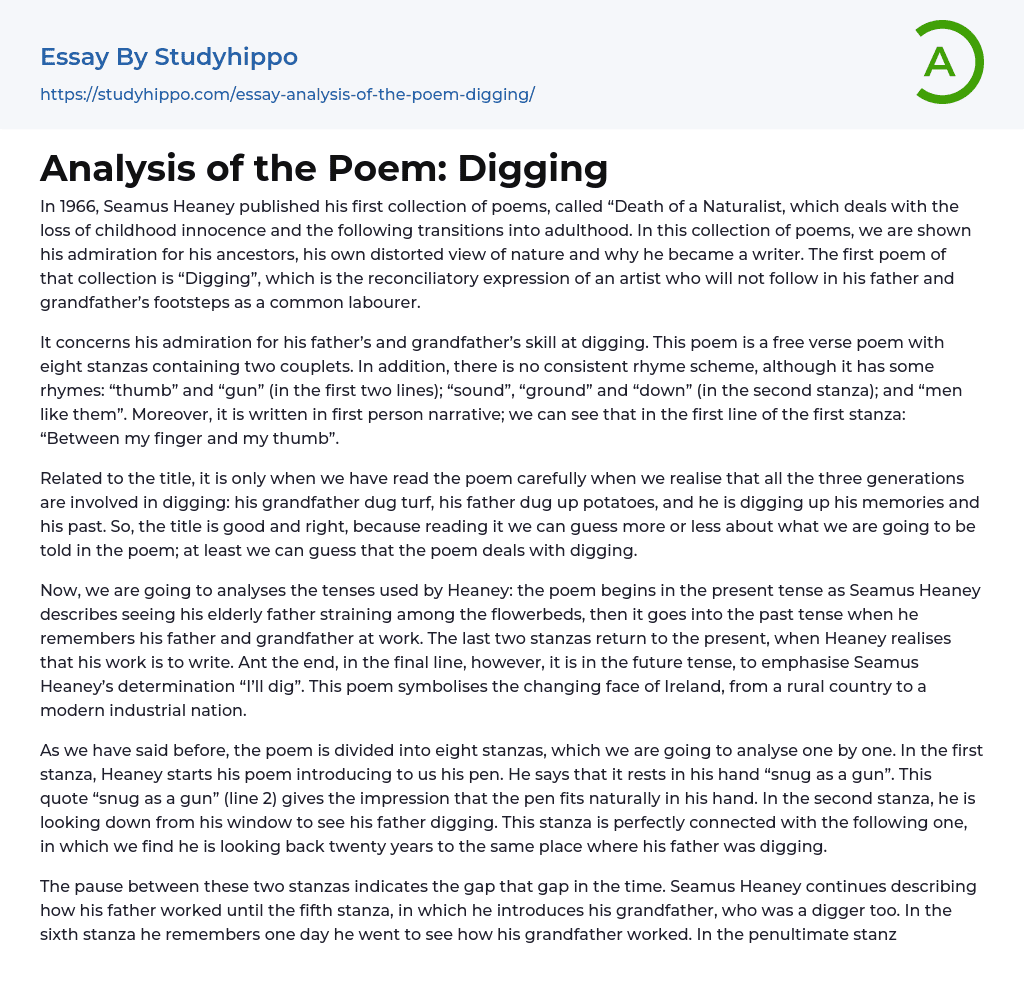In 1966, Seamus Heaney published his first collection of poems, called “Death of a Naturalist, which deals with the loss of childhood innocence and the following transitions into adulthood. In this collection of poems, we are shown his admiration for his ancestors, his own distorted view of nature and why he became a writer. The first poem of that collection is “Digging”, which is the reconciliatory expression of an artist who will not follow in his father and grandfather’s footsteps as a common labourer.
It concerns his admiration for his father’s and grandfather’s skill at digging. This poem is a free verse poem with eight stanzas containing two couplets. In addition, there is no consistent rhyme scheme, although it has some rhymes: “thumb” and “gun” (i
...n the first two lines); “sound”, “ground” and “down” (in the second stanza); and “men like them”. Moreover, it is written in first person narrative; we can see that in the first line of the first stanza: “Between my finger and my thumb”.
Related to the title, it is only when we have read the poem carefully when we realise that all the three generations are involved in digging: his grandfather dug turf, his father dug up potatoes, and he is digging up his memories and his past. So, the title is good and right, because reading it we can guess more or less about what we are going to be told in the poem; at least we can guess that the poem deals with digging.
Now, we are going to analyses the tenses used by Heaney: the poem begins in the present tense as
Seamus Heaney describes seeing his elderly father straining among the flowerbeds, then it goes into the past tense when he remembers his father and grandfather at work. The last two stanzas return to the present, when Heaney realises that his work is to write. Ant the end, in the final line, however, it is in the future tense, to emphasise Seamus Heaney’s determination “I’ll dig”. This poem symbolises the changing face of Ireland, from a rural country to a modern industrial nation.
As we have said before, the poem is divided into eight stanzas, which we are going to analyse one by one. In the first stanza, Heaney starts his poem introducing to us his pen. He says that it rests in his hand “snug as a gun”. This quote “snug as a gun” (line 2) gives the impression that the pen fits naturally in his hand. In the second stanza, he is looking down from his window to see his father digging. This stanza is perfectly connected with the following one, in which we find he is looking back twenty years to the same place where his father was digging.
The pause between these two stanzas indicates the gap that gap in the time. Seamus Heaney continues describing how his father worked until the fifth stanza, in which he introduces his grandfather, who was a digger too. In the sixth stanza he remembers one day he went to see how his grandfather worked. In the penultimate stanza, Heaney gives us “the cold smell of potato mold”, the sound of “squelch and slap” all this, help us to make more vivid what he
describes.
Moreover in that stanza he realises that his work is writing and not digging: “I’ve no spade to follow men like them”. In the last stanza Heaney repeats the opening lines “Between my finger and my thumb / the squad pen rest”. Now the image of the pen as a gun is replaced by “I’ll dig it”. So, now his pen becomes a metaphorical spade, which suggests that his pen is like his took, as the spades were the tools of his father and grandfather. So, he will continue with his work, digging in his memories through writing.
- Boo Radley essays
- Genesis essays
- Richard iii essays
- Alice in Wonderland essays
- On the road essays
- Ozymandias essays
- The Nightingale essays
- Holden Caulfield essays
- Animal Farm essays
- 1984 essays
- A Hanging essays
- Shooting An Elephant essays
- A Tale Of Two Cities essays
- Adventures Of Huckleberry Finn essays
- Arthur Conan Doyle essays
- Brave New World essays
- Characters In Hamlet essays
- Characters In Romeo And Juliet essays
- Desdemona essays
- Diary Of A Wimpy Kid essays
- First-Person Narrative essays
- Frankenstein essays
- Heart Of Darkness essays
- Jane Eyre essays
- Jay Gatsby essays
- King Duncan essays
- Librarian essays
- Little Red Riding Hood essays
- Lord Of The Flies essays
- Silas Marner essays
- The Cask Of Amontillado essays
- The Catcher In The Rye essays
- The Crucible essays
- The Handmaid's Tale essays
- The Reader essays
- Virgil essays
- Wuthering Heights essays
- Candide essays
- Castle essays
- J. D. Salinger essays
- Ulysses essays
- Ethan Frome essays
- In Cold Blood essays
- Outliers essays
- Tuesdays With Morrie essays
- The Art of War essays
- Wife of Bath essays
- Huckleberry Finn essays
- The Lady With The Dog essays
- Great Expectations essays




